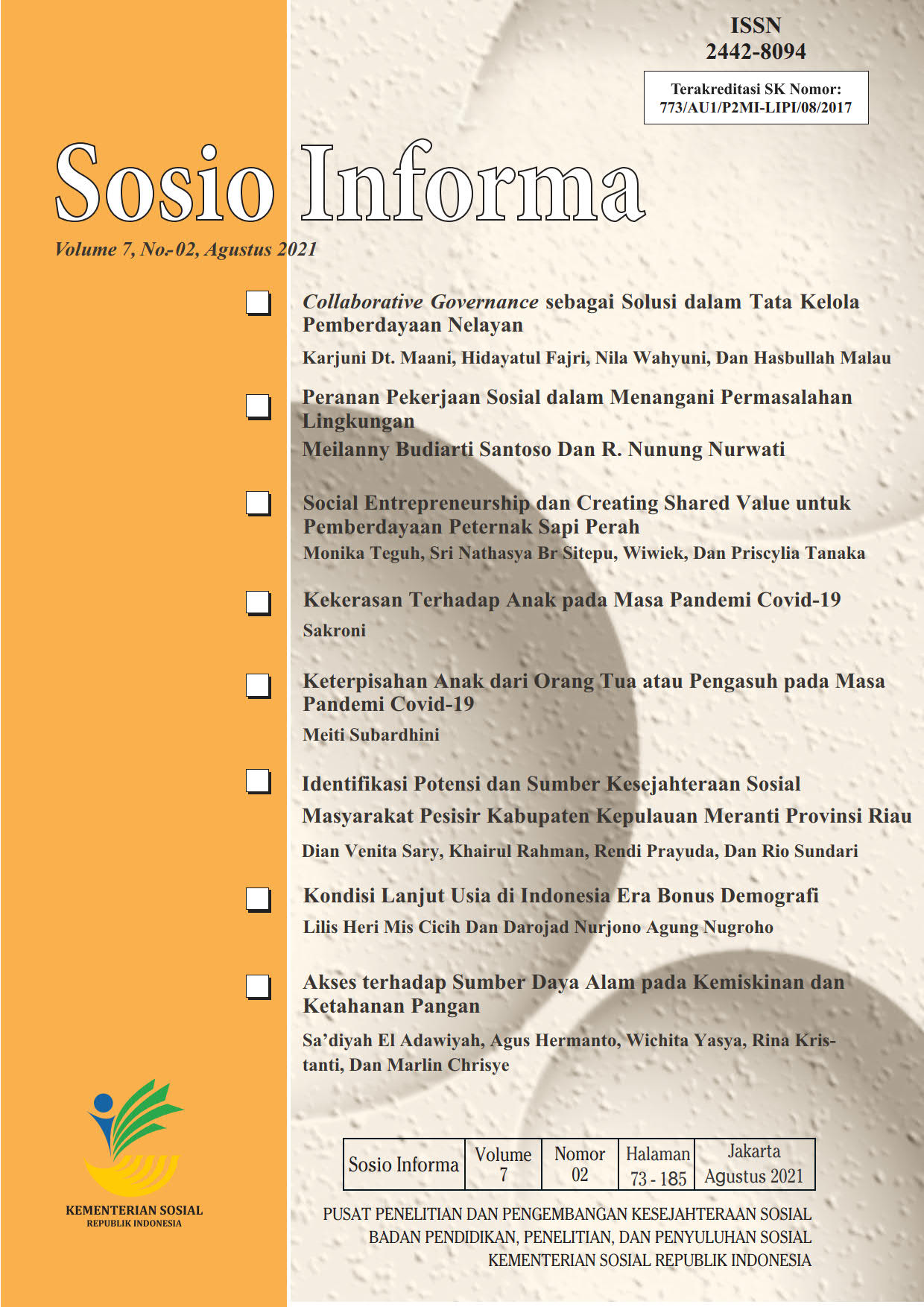KONDISI LANJUT USIA DI INDONESIA ERA BONUS DEMOGRAFI
DOI:
https://doi.org/10.33007/inf.v7i2.2681Keywords:
bonus demografi, jendela kesempatan, rasio ketergantungan, lanjut usia, kualitas manusiaAbstract
Saat ini Indonesia sedang memasuki era Bonus Demografi. Namun untuk dapat meraihnya, terdapat tantangan besar yang harus dihadapi yaitu kebutuhan akan kualitas sumber daya manusia yang unggul dan berdaya saing. Hal ini juga menjadi tantangan dalam menyongsong era Bonus Demografi kedua seiring meningkatnya jumlah lanjut usia. Terkait dengan persyaratan tersebut, kajian ini memberikan gambaran kondisi lanjut usia dan capaian parameter demografi provinsi di era Bonus Demografi. Sumber data kajian adalah Survei Sosial Ekonomi Nasional (SUSENAS) Tahun 2019, dan hasil proyeksi penduduk Survei Penduduk Antar Sensus (SUPAS) 2015. Data hasil kajian disajikan secara deksriptif dalam bentuk tabel dan gambar. Kondisi lanjut usia dilihat dari sosial, ekonomi, dan kesehatan, dan parameter demografi provinsi dilihat dari fertilitas, mortalitas, dan migrasi. Hasil kajian memperlihatkan bahwa pada saat era Bonus Demografi, kondisi lanjut usia masih didominasi oleh mereka yang tingkat sosial ekonominya rendah. Dari sisi kesehatan, 26,2 persen lanjut usia mengalami keluhan kesehatan hingga mengganggu aktivitas mereka sehari-hari. Pada tingkat provinsi, beberapa provinsi masih memerlukan peningkatan penanganan fertilitas dan mortalitas. Berbagai upaya perlu dilakukan oleh pemerintah bersama pemangku kepentingan lainnya untuk meningkatkan kondisi lanjut usia melalui pendidikan, ekonomi, dan kesehatan penduduk untuk menjadi lanjut usia dengan masa depan yang lebih berkualitas. Itu sebabnya, penduduk perlu dibekali dengan pengetahuan, keterampilan, dan akses untuk persiapan masa tua.
References
Badan Pusat Statistik. (2013). Proyeksi Penduduk Indonesia 2010-2035.
Badan Pusat Statistik. (2018). Proyeksi Penduduk Indonesia 2015-2045. Hasil SUPAS 2015. Jakarta: BPS.
Badan Pusat Statistik. (2019). Statistik Penduduk Lanjut Usia 2019.
Barsukov, V. N. (2019). From the Demographic Dividend to Population Ageing: World Trends in the System-Wide Transition. Economic and Social Changes: Facts, Trends, Forecast, 12(4), 167–182. doi: 10.15838/esc.2019.4.64.11.
BKKBN. (2020). Rencana Strategis BKKBN 2020-2024. 1–71.
Chen, Q., Kong, Y., Gao, W., & Mo, L. (2018). Effects of Socioeconomic Status, Parent-Child Relationship, and Learning Motivation on Reading Ability. Frontiers in psychology, 9(1297). https://doi.org/10.3389/fpsyg.2018.01297
Cuaresma, J. C., Lutz, W., & Sanderson, W. (2014). Is the Demographic Dividend an Education Dividend? Demography, 51(1), 299–315. doi: 10.1007/s13524-013-0245-x.
Dobrokhleb, V. G., Barsukov, V. N. (2017). Demographic Theories and the Regional Aspect of Population Ageing. Economic and Social Changes: Facts, Trends, Forecast, 10(6), 89–103. doi: 10.15838/esc.2017.6.54.6.
Gribble, J. N., Brenner, J. (2012). Achieving a Demographic Dividend. Population Bulletin, 67(2), 1–15.
Hayes, A. (2014). The Mixed Blessing of Asia’s Growing Middle Class.”East Asia Forum Quarterly, 6(4), 23–26.
Hayes, A., Setyonaluri, D. Taking Advantage of The Demographic Dividend in Indonesia: A Brief Introduction to Theory and Practice, (2015, April).
Lee, R. D., Mason, A. (2006). What Is the Demographic Dividend? Finance and Development, 43(3), 16–17.
Mason, A., Lee, R., & Jiang, J. X. (2016). Demographic Dividends, Human Capital, and Saving. Journal of the economics of ageing, 7, 106–122. https://doi.org/10.1016/j.jeoa.2016.02.004.
Mihra, S. (2015). The Economy in Indonesia’s Ascent: Making Sense of it All. In Roberts, C. B., Habir, A. D., & Sebastian, L. C. (Ed.), Indonesia’s Ascent: Power, Leadership, and the Regional Order (Vol. 1, pp. 40–68). Palgrave Macmillan.
Pavela, G. (2015). Functional Status and Social Contact Among Older Adults. Research on Aging 37(8),815–836. doi: 10.1177/0164027514566091.
Washington Group. (2017). Overview of Disability Measurement and the Washington Group Short Set The State of Disability Data [Slides]. Washingtongroup-Disability.Com. https://www.washingtongroup-disability.com/fileadmin/uploads/wg/Documents/Presentation_1_-_Overview_of_Disability_Measurement_and_the_WG.ppt
Wisnumurti, A. A. G. O., Darma, I. K. & Suasih, N. N. R. (2018). Government Policy of Indonesia to Managing Demographic Bonus and Creating Indonesia Gold in 2045. Journal Of Humanities And Social Science (IOSR-JHSS), 23 (1). pp. 23-34.
Woetzel, Tonby, Thompson, & Lee. (2014, November). Southeast Asia at the Crossroads : Three Paths to Prosperity. McKinsey Global Institute. https://www.mckinsey.com/~/media/McKinsey/Featured%20Insights/Asia%20Pacific/Three%20paths%20to%20sustained%20economic%20growth%20in%20Southeast%20Asia/MGI%20SE%20Asia_Executive%20summary_November%202014.pdf
Wongboonsin, K., Wongboonsin, P. (2005). First and Second Demographic Dividend [Slides]. Ocw.Kyoto-u.Ac. https://ocw.kyoto-u.ac.jp/wp-content/uploads/2009/04/2009_shinmitukentokoukyouken_1.pdf
Downloads
Published
How to Cite
Issue
Section
Citation Check
License
Copyright (c) 2021 Lilis Heri Mis Cicih

This work is licensed under a Creative Commons Attribution-NonCommercial-ShareAlike 4.0 International License.
Authors who publish with this journal agree to the following terms:
- Authors retain copyright and grant the journal right of first publication with the work simultaneously licensed under a Creative Commons Attribution-NonCommercial-ShareAlike 4.0 International License that allows others to share the work with an acknowledgement of the work's authorship and initial publication in this journal.
- Authors are able to enter into separate, additional contractual arrangements for the non-exclusive distribution of the journal's published version of the work (e.g., post it to an institutional repository or publish it in a book), with an acknowledgement of its initial publication in this journal.
- Authors are permitted and encouraged to post their work online (e.g., in institutional repositories or on their website) prior to and during the submission process, as it can lead to productive exchanges, as well as earlier and greater citation of published work (See The Effect of Open Access).









